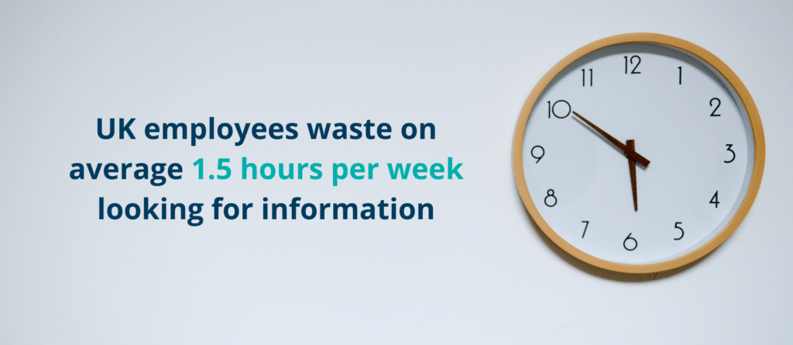Data Silos: What Are They and How Do You Fix Them?
by Conosco on Jan 26, 2021

Written by Jon Taylor, Principal Consultant at Conosco
Data silos prevent employees from easily accessing and sharing important information from across the organisation and using it to drive intelligent business decisions. What can your business do to fix them?
Data is one of the most valuable resources a business has. It enables organisations to gain insights into their customers and tailor experiences to suit their needs, it drives operational decisions and it forms the basis of many organisation’s strategies. It is estimated that 2.5 quintillion bytes of data is produced every day, and as technology advances and more devices are connected (thanks to IoT) this number is set to rise.
However, this presents a new challenge – how do you stop data silos and enable information to flow seamlessly throughout your business?
In this blog, we outline some basic approaches to avoid and resolve data silos, so that your organisation can make more informed decisions which are central to growth and profitability.
What is a data silo and what causes them?
First, let’s look at what a silo is. In agriculture, a silo is used to store grain and feed in structures such as towers. They are deliberately built separately to each other to prevent cross-contamination.
Similarly, a data silo in an organisation is where data and information are stored in isolated spaces. Unfortunately, this can cause inefficiencies and hinder effective collaboration.
Data silos can form as a result of several factors:
Organisational data silos
Data is kept within a department or office and is isolated from the rest of the organisation. For example, web traffic statistics are kept within the Marketing team and reported upward to the CMO, whilst sales data is kept within the Finance team and reported upward to the CFO. Data produced by both departments could be beneficial to the other but due to data isolation information is never exchanged.
This type of data silo sometimes occurs due to structural changes, such as when an organisation expands rapidly bringing in new staff, causing the lines of inter-departmental communication to get lost.
Technical data silos
There may be multiple systems across the organisation that are not integrated meaning information cannot pass between them. It may be a legacy system that cannot transfer data natively, or perhaps the technology vendor has locked down the data meaning transfer is impossible. In some instances the data silo has been caused due to poor implementation and lack of training, leaving employees unaware of how to share information despite the capability being there.
Cultural data silos
Staff are not empowered to share data within the organisation due to competition between employees or a need for control. Data may be further restricted within a management hierarchy.
What impact can data silos have on your business?
Data silos impact your ability to manage data within your organisation and can lead to a lack of transparency and efficiency across the business. Some key issues of poor data management caused by data silos include:
- Loss of time and productivity
When data is segmented across different departments, applications, spreadsheets and technology it can be hard to find what you need. According to one study, UK employees waste on average 1.5 hours per week looking for information. Data silos often mean employees are less productive as they spend more time searching for information as opposed to analysing it. - Cost inefficiency
Data silos are essentially a waste of resources and money. If information cannot flow throughout a business and be available to the people that need it, then the processes/technology are ineffective. - Inability to collaborate
Businesses rely on data and information being accessible, however, if your technology does not support simple data transfer it can make it difficult to collaborate on projects. - Inaccurate data
Data silos often lead to several versions of the same information being stored and edited in multiple locations. This can lead to inaccuracy with no single version of the truth. This can have a serious impact on a business’s ability to analyse and forecast correctly.

What can be done to avoid and fix data silos?
Data silos are harmful to your business so what can you do to avoid creating them? And how can you break down existing silos? We’ve put together 7 easy steps:
- Identify your data silos
- Remove outdated data
- Reduce the number of applications/systems you use
- Use native integrations
- Unify data with an integrator
- Encourage collaboration
- Future proof your business in the cloud
Step 1: Identify your data silos
The first step to disassemble data silos is to identify them. Communicating with key stakeholders, and different departments across your organisation will give you an understanding of the processes and systems they use. You’ll then need to categorise the types of information you collect, process and store. This may include:
- Customer Account Data
- Operational Data
- Customer Experience Data
- Financial Data
- Marketing Data
Identifying the data you have across all systems will help you recognise where collaboration would be advantageous. With a holistic view of your company’s information, you’ll be better equipped to break down data silos.
Step 2: Remove outdated data
Storing data costs money. If it’s outdated why are you keeping it? Similarly, if staff are storing local versions or if you are operating multiple systems with the same information you are wasting precious storage space. Streamlining your data and having one platform whereby employees can access the latest and most accurate information will reduce costs and improve the employee experience.
If you have followed step 1 then you’ll already know what information you collect. You will now need to deep-dive into the data and remove any duplication or outdated information. The most efficient way to do this is to assign a team of business data owners. They will be responsible for working through all data and ensuring it is relevant and justified. They will need to ask important questions like:
- Why is it being gathered and stored?
- Where is it being stored?
- Is the old data required for legal reasons? If so, then can we archive it?
- Do we need to build a business case to remove data?
You may also want to work with your internal Data Protection Officer or enlist the support on an outsourced vDPO (Virtual Data Protection Officer) to ensure that any information your business collects is GDPR compliant.
Step 3: Reduce the number of systems/applications in use across your organisation
Too many diverse systems add to data complexity which can lend itself to data silos. One study showed that on average 508 applications are in use within each business. Before you start investing in new technology, take a critical look at your current infrastructure. Can any of your existing systems be leveraged further across other functional areas enabling you to remove the now redundant system?
By introducing standardisation across your organisation it will make it easier to collect information in a similar format and streamline the user experience, collection methods and reporting.

Step 4: Opt for systems that offer native integrations
Most modern systems will permit native data integration. For example, CRM systems will integrate with other marketing tools and financial systems with e-commerce or billing applications. Integrated platforms can share information and therefore present a single holistic view of the data.
Whilst many apps do have native integration it is impossible to have this ability for every tool. Choose carefully when investing in new technology. Is the system capable of integrating with your existing systems? Talk to your vendors. If it’s not available, then why? Is it on their product roadmap? If not, then why? Having data locked in is not a desirable situation for any organisation.
Step 5: Unify data with an integrator
If your systems don’t have native integrations available, then a potential solution is to consolidate data via a web-based integration platform. Whilst this will have long term benefits it is often a large-scale project. Many businesses will work alongside IT providers or technical specialists who are best-placed to understand what type of integrations you will need and how to build a platform that achieves your goals. At Conosco our cloud experts can work with you to configure a tailored integration solution.
Step 6: Encourage collaboration within your organisation
Not all data silos exist due to technological reasons some are a result of ingrained cultural behaviours. If you are to successfully grow, your teams should be aware of the challenges of siloed data such as the financial implications and negative impact on decision making. By fostering a collaborative approach, led top-down from your c-level executives to your junior assistants, employees will feel encouraged to share data and work together to achieve your company’s vision.
Step 7: Future-proof your business in the cloud
By its very nature, the cloud lends itself to centralising data from multiple sources whilst being readily accessible from all locations. Whether you use cloud-based Integration Platforms as a Service (IPaaS) or you opt for cloud-native applications to host your data, the cloud offers unlimited storage capacity, built-in features that can automatically update information, tools for data analysis and ultimately provides better customer and employee experiences.
Conosco’s cloud computing team consists of cloud migrations experts, AWS and Azure consultants, with the experience to support businesses transitioning from legacy systems to more dynamic cloud environments. We’ll always ensure the integrity of your data whilst also building a flexible infrastructure which lends itself to collaboration and reduces the risk of data silos.
Round-Up
The challenges posed by data silos may seem daunting but perfection is not required to see benefits. Start small, identify silos and eliminate outdated or inaccurate data. Once you’ve got a strong grip over your current environment you can then start making changes to your infrastructure, reducing the number of applications, integrating systems and promoting collaboration.
Following your hard work, measures will need to be put in place to stop data isolation from reoccurring. New systems should be governed, and if required have native data integration in line with your goals. You should also consider building regular data reviews and systems audits into your IT strategy.
For more information about fixing data silos and building a technology strategy aligned with your business objectives get in touch with Conosco’s ‘Advantage’ team. Made up of strategic consultants, vCIOs, vCTOs and vCISOs, we’ll give you the leadership advice and technical expertise to create an IT estate on which to succeed.
You May Also Like
These Related Stories

The Challenges of Digital Transformation in the Public Sector
Written by Russell Hallam, Business Development Manager at Conosco Digital Transformation in the public sector has accel …

Public Sector Data Management: 6 Lessons from the Track and Trace Blunder
Written by Jon Taylor, Principal Consultant at Conosco The public sector often comes under close scrutiny, but in the mi …

8 Benefits Of Digital Transformation For Your Employees (2021)
Written by Noel Thompson, Director of South Africa Over the past year, we’ve seen the rapid development and installation …

